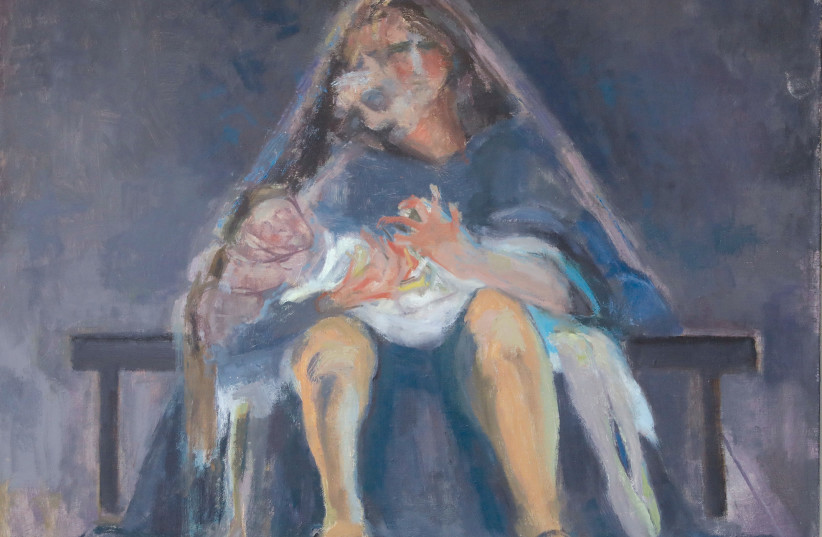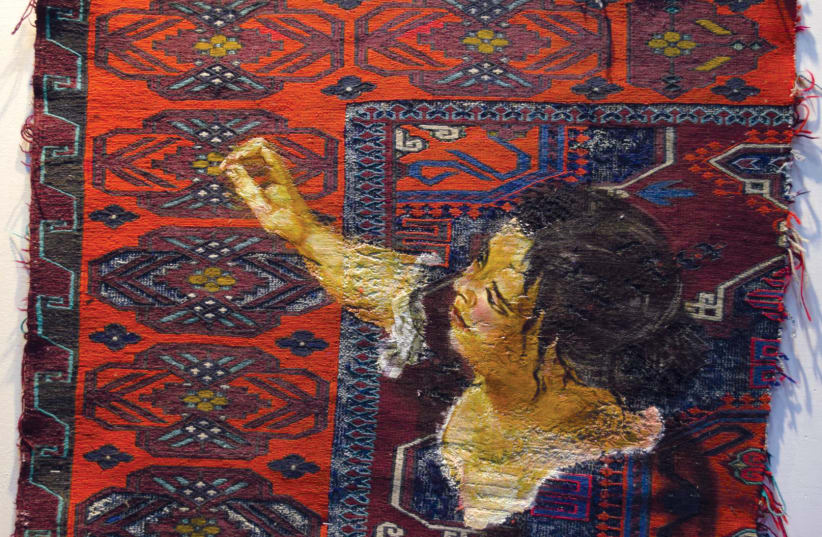When Nomi Tannhauser began working on a series of artworks honoring her late mother, Pia Miglioretto, she began exploring this question: How is an icon different from a painting?
The answer can be seen at Wonder Woman, a new group exhibition where her works will be shown alongside new paintings by Parvin Shmueli Buchnik, Sarith Leila Haas and Heddy Breuer Abramowitz, which opens on Thursday at 7 p.m. at Marie Gallery on 12 Agrippas St.
While Tannhauser drew inspiration from the 4th-century Roman mosaic in Tzipori, Buchnik continued her deep interest in an East-West cultural dialogue.
In earlier works, Buchnik included her Iranian-Jewish heritage by depicting herself as a veiled Mona Lisa or an oriental dancer in juxtaposition against Botticelli’s 1486 painting The Birth of Venus.
Here she presents a homage to Self-Portrait as the Allegory of Painting, a 1639 painting by Artemisia Gentileschi. The Italian Baroque artist is presented as if she is painting an ornamented Persian carpet.


“What I am dealing with in this exhibition,” Tannhauser says, “is how it is like to grow up with a non-Jewish Swiss mother.”
Noting that she grew up keenly aware of how her mother was defined by what she is not, she adds that “she was many things, but Jewish was not one of them.”
In Israel, she points out, “people know Poland and Morocco. Swiss people are not common.”
Tannhauser, born in Chicago to a German-Jewish father and a Swiss mother, is actually the second generation in her family to embrace mixed marriages.
Her maternal grandfather was a Catholic Italian who converted to Protestantism to blend in. In a series of portraits, of her mother and of herself, Tannhauser uses gold paint and colorful clay pebbles to doubly insert her mother. First as a local icon of female beauty, equal to the Mona Lisa, and secondly as someone who truly belongs to this land.
“In Israel,” she says of her mother, “she sort of relived the time of Jesus.”
Family relations, especially from the perspective of second-generation children of Holocaust survivors, is also explored in the works of Sarith Leila Haas.
In The Sisters painting, a cycle of misery is broken by a little smile.
The artist warmly described the process of working on the exhibition with the other three artists as one of finding sisterhood and strength.
“Each one of us is a wonder woman,” she wrote on social media, “especially at such an age. Each one an Amazon, no less so than the amazons depicted in the Sepphoris mosaic.”
“We are all in our 60s and have a lot of experience in the art world,” Abramowitz says. “One of the things we’re about is presenting works by artists who have experienced ageism.”
As fitting a feminist art space, it is named after a woman, Marie, a Lebanese-Jewish woman who lived in the former apartment and was the mother-in-law of gallery cofounder Riva Pinsky-Awadish.
This meshes well with the long-held commitment Tannhauser has to honoring past artists and opening opportunities to women.
When she cofounded the Antea art gallery with Rita Mendes-Flohr in 1994 at Kol Ha’isha, a Jerusalem feminist center, the name was suggested by Joanna Ryan, who operated a same-named gallery in Tel Aviv in the 1980s.
Antea honored Pamela Levy after her passing by curating a splendid 2005 exhibition of her works titled Thank You Pamela. It would take 12 more years for Levy’s paintings to be shown at the Tel Aviv Museum of Art.
“When I came back here from studying art in New York City I sought people who could understand me,” Tannhauser tells me. In the Israeli art world at the time, painting was announced dead and gone. But in NYC, where she saw works by Keith Haring on the subway walls, painting was alive and kicking.
“Both Pamela and Pesach Slabosky were older Americans, and they could tell me it was okay to paint,” she adds. She would curate, alongside Oree Holban, an exhibition of his works as well as after his death in 2019.
“I do see history,” Tannhauser reflects. “It was an historically important gallery. Even if some thought it would be placing our works in a sort of ghetto.”
Antea closed in 2009, yet 10 years later roughly one hundred artists, men as well as women, took part in Her Dress, Her Symbol: Antea Revisted, which she co-curated with Mendes-Flohr.
When Tannhauser joined Marie Gallery in October she began thinking on what to do in it. This group of artists, all somehow similar, all very different, “connected perfectly,” she exclaimed.
“We had such great rapport, so much tenderness and empathy. All of our decisions were taken together, we each had to feel comfortable with all aspects of the work,” she shared.
Abramowitz will be showing for the first time a 2017 painting dealing with the difficult theme of losing a child.
Tilted For All Grieving Mothers, it is inspired by the Christian pietà tradition of presenting Maria grieving the death of her son, it is a powerful expression of sorrow and anguish.
The artist had lost a daughter, Talia Zwebner, in 2015, and the painting is deeply moving.
“It was a long hard process to get back to painting,” she says. “How to feel any of this is worthwhile?”
“There is so much suffering in the world,” she explains about that long time of inner searching. “Does it matter what I paint?
“It weighed on me to find a proper image to express what I was feeling. Out of this grapple came the pietà.”
She added that one of the titles she considered for the work, and put aside, was “What if Mary Had Lost a Daughter?” It is an interesting idea; would the loss of a daughter still have brought us Christianity?
Known as a landscape painter with a special interest in Jerusalem, she confesses to not having painted such works since COVID-19 erupted two years ago.
The exhibition does include a painting of a memorial candle with the image of Rachel’s Tomb.
“To me,” she concludes, “this is a part of Jerusalem. It speaks to me as an iconic Jewish image.”
“Jerusalem,” Abramowitz says, “is a part of me, I never know when it is going to pop up.”
“For me,” Tannhauser says, “living in Jerusalem is multilayered. It is a very deep feeling of history.” ❖
Wonder Woman, a group exhibition of new works by Sarith Leila Haas, Heddy Breuer Abramowitz, Nomi Tannhauser and Parvin Shmueli Buchnik, opens on Thursday at 7 p.m. at Marie Gallery (12 Agrippas St.) and closes on Saturday, June 25 at 2 p.m. Admission is free.
Opening Hours: Monday to Thursday from 4:30 p.m. to 7:30 p.m. Friday to Saturday from 11 a.m. to 2 p.m.
